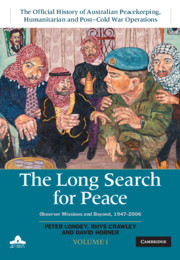Book contents
- The Long Search for Peace
- The Official History of Australian Peacekeeping, Humanitarian and Post–Cold War Operations
- The Long Search for Peace
- Copyright page
- Contents
- Maps
- Preface
- Glossary
- Part 1 Actor and observer
- 1 The origins of peacekeeping
- 2 St George and the maiden
- 3 Inventing peacekeeping
- 4 Failure
- 5 Success
- 6 Observing at a critical moment
- 7 An intractable dispute
- 8 ‘Tough men wanted’
- 9 Australia and the problem of Palestine
- 10 The Six Day War and after
- 11 ‘If you’re not confused, you don’t understand the situation’
- 12 Over jungle and swamp
- 13 A reluctant start
- 14 The first decade
- 15 Australia and the invention of peacekeeping
- Part 2 New ambitions
- Part 3 Carrying on
- Conclusion
- Book part
- Bibliography
- Index
- Plate Section (PDF Only)
10 - The Six Day War and after
Australians in the Middle East, 1967–73
from Part 1 - Actor and observer
Published online by Cambridge University Press: 27 September 2019
- The Long Search for Peace
- The Official History of Australian Peacekeeping, Humanitarian and Post–Cold War Operations
- The Long Search for Peace
- Copyright page
- Contents
- Maps
- Preface
- Glossary
- Part 1 Actor and observer
- 1 The origins of peacekeeping
- 2 St George and the maiden
- 3 Inventing peacekeeping
- 4 Failure
- 5 Success
- 6 Observing at a critical moment
- 7 An intractable dispute
- 8 ‘Tough men wanted’
- 9 Australia and the problem of Palestine
- 10 The Six Day War and after
- 11 ‘If you’re not confused, you don’t understand the situation’
- 12 Over jungle and swamp
- 13 A reluctant start
- 14 The first decade
- 15 Australia and the invention of peacekeeping
- Part 2 New ambitions
- Part 3 Carrying on
- Conclusion
- Book part
- Bibliography
- Index
- Plate Section (PDF Only)
Summary
In June 1967 the Arabs and Israelis fought a war that lasted for just six days but changed the face of the Middle East. For the United Nations Truce Supervision Organization (Untso), the challenges were immense. For the previous 19 years Untso’s operations, centred on the four Mixed Armistice Commissions (MACs) described in chapter 9, had plotted a more or less steady course, although there had been plenty of tensions. But in three of Untso’s four areas of operation, the 1967 war ended with radically changed boundaries between the belligerents and an entirely new geography of peace for the observers to monitor. For the next six years, Untso had to meet the new challenges unaided: it was only after the 1973 war that new UN missions were set up in the Sinai and on the Golan (see chapters 20 and 21). This chapter shows how Untso was able to reposition itself – literally as well as figuratively – to respond to the new environment after 1967 and describes the key roles played by Australians in that process.
- Type
- Chapter
- Information
- The Long Search for PeaceObserver Missions and Beyond, 1947–2006, pp. 251 - 276Publisher: Cambridge University PressPrint publication year: 2019

